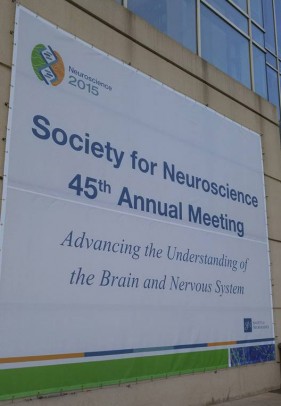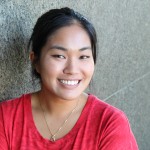Brain Power in Chicago
 This year, the 45th annual Society for Neuroscience (SfN) convention was held October 17-21. SfN, founded in 1969, is the largest organization in the world devoted to understanding and investigating the brain and the nervous system. The annual SfN convention is an enormous gathering of over 30,000 people that come from 80 different countries to present emerging neuroscience research, learn and collaborate from other experts, and explore groundbreaking technologies in science. It is truly a remarkable five-day congregation of ideas and tools for global neuroscience and an incredible place of learning for anyone interested in the field; so, it was very fortuitous for all neuroscientists in Chicago this year that the annual SfN convention was hosted right here at McCormick Place!
This year, the 45th annual Society for Neuroscience (SfN) convention was held October 17-21. SfN, founded in 1969, is the largest organization in the world devoted to understanding and investigating the brain and the nervous system. The annual SfN convention is an enormous gathering of over 30,000 people that come from 80 different countries to present emerging neuroscience research, learn and collaborate from other experts, and explore groundbreaking technologies in science. It is truly a remarkable five-day congregation of ideas and tools for global neuroscience and an incredible place of learning for anyone interested in the field; so, it was very fortuitous for all neuroscientists in Chicago this year that the annual SfN convention was hosted right here at McCormick Place!
On Saturday, October 17th, I had the privilege of attending SfN free of cost, thanks to the UIC Laboratory of Integrative Neuroscience. UIC supported the $300 registration cost of 50 undergraduate neuroscience students, allowing us to attend one day (Saturday or Sunday) of the convention to attend symposiums and lectures, explore countless poster presentations and venues, and network with neuroscientists from around the world. The last time SfN was hosted in Chicago was back in 2009, so it is definitely a special treat for all neuroscientists in the area to have this huge convention right here in Chitown. As a senior in neuroscience, I leaped at the opportunity to go, and with the help of other neuroscience undergraduates, Meghana Yerrapothu and Alexis Reisch (they’re also the founders of Nu Rho Psi, UIC’s chapter of the National Honors Society in Neuroscience!), my registration was arranged the same week of the conference.
With thousands of presentations, symposiums, and posters to see, it was a little overwhelming to even plan an itinerary for one day. In preparation, Dr. Paul Malchow, director of UIC LIN, and Dr. Mitch Roitman, associate director, gave a short presentation to all the students that included tips on how to plan. Dr. Roitman is also my past PSCH 262 and current PSCH 363 (behavioral neuroscience lab) professor. After hearing him and Dr. Malchow speak about the cutting-edge research, world-renowned scientists, and Nobel Prize winners at the convention, all of the students were even more galvanized to go. I downloaded the SfN mobile app and tagged a number of mini-symposiums, lectures, and presentations I wanted to check out to be sure I could gain as much as I could from the short time I would have at McCormick Place.
On Saturday, I arrived shortly after noon and received my registration badge with the help of a UIC graduate student. Even with all my preparation, I still felt overwhelmed at first entrance inside the huge exhibition hall of posters — I didn’t know where to start! I spent the few hour meandering through the dozens of poster aisles, perusing those I found interesting and engaging in conversation with some brilliant individuals who were also patient about explaining their project. One incredible aspect to me was how specific the research topics are, such as investigating the inhibition and activation of a single protein or gene. I found myself particularly drawn to the poster section for neurodegenerative diseases and disorders. There were countless posters about causes and treatments for Alzheimer’s disease and Parkinson’s disease; I also learned about fascinating research that could potentially restore walking behavior for individuals with severe spinal injuries from traumatic accidents!
One of the most interesting poster presentations I listened to was actually delivered by two women neuroscientists from Mexico City who studied predispositions to post-partum depression in women. What perhaps made it even more memorable was the language barrier, as they did not speak fluent English; I actually ended up practicing a little bit of Spanish with them! Having never been to Chicago, they were enthused to be presenting their research here, and they were interested to hear about my experience as an undergraduate neuroscience student at UIC. It was incredible to form a cross-cultural bond over neuroscience, and I’m very happy I got the chance to meet them!
After browsing the posters, I attended a few nanosymposisum (short 15 minute presentations) that also centered on neurological disorders. The talks were definitely a challenge to understand since much of the scientific terminology used was beyond my level; however, the researchers were excellent at simplifying the material on their slides, and I was able to piece together the purpose and results of the experiments. For instance, at the end of one nanosymposium, I probably couldn’t explain the mechanisms behind the protein misfolding that is suspected to causes familial ALS disease; but I do remember that it is supposedly linked to over 150 mutations in the SOD1 gene and over 40 mutations in the FUS gene.
I ended my day at the convention by attending the Presidential Special Lecture, which featured Dr. Cori Bargmann, who is an incredible force in the global neuroscience community for her work on animal behavior with C. elegans worms. Dr. Bargmann is a member of the National Academy of Sciences and the American Academy of Arts and Sciences, and she has won numerous awards for her contributions to the field, including the $3 million Breakthrough Award in Life Sciences and the $1 million Kavil Prize in Neuroscience. My friends and I arrived a little early to get a good spot for the talk, and by the time she began, the entire area was packed! It seemed like everyone at the convention had planned to hear her speak.
Dr. Bargmann spoke on themes and variations in behavior and what give rise to flexible behaviors based on studies on C. elegans foraging behaviors. In describing behavioral variability, Dr. Bargmann explained how neuromodulators such as serotonin play a role in increasing dwelling states, which cause the animal to be stationary for a longer time; the neuropeptide PDF (pigment-dispensing factor) plays a role in inducing dwelling as well. Dr. Bargmann then discussed how foraging strategies vary within and between species and how the variability arises in the circuit itself. Depending on certain neuron activations, animals may be prompted to either move or stay. Dr. Bargmann was a phenomenal speaker, and she was able to break down complex concepts into understandable and engaging explanations for members of the audience at all levels of study in neuroscience.
From the people I met to the speakers I heard and the knowledge I learned, my time at SfN was memorable indeed, and I am so grateful to UIC LIN for the chance to attend! After being a neuroscience student for years now, I finally had a firsthand look at how scientists contribute to the knowledge base of the field and how research is being used to directly benefit people of the world. It also reinvigorates my own curiosity and motivation — and perhaps one of my fellow neuroscience colleagues at UIC will be the next big name in the field!
 Sarah Lee is a senior studying neuroscience and Russian in the GPPA Medicine program at UIC. She’s still trying to figure out exactly what she wants to do, but some of life goals include running a marathon, exploring Eastern Europe and becoming fluent in Russian. In her free time, she loves running, playing piano and guitar, and reading. A Naperville native, Sarah is a peer mentor in the Courtyard residence hall.
Sarah Lee is a senior studying neuroscience and Russian in the GPPA Medicine program at UIC. She’s still trying to figure out exactly what she wants to do, but some of life goals include running a marathon, exploring Eastern Europe and becoming fluent in Russian. In her free time, she loves running, playing piano and guitar, and reading. A Naperville native, Sarah is a peer mentor in the Courtyard residence hall.
